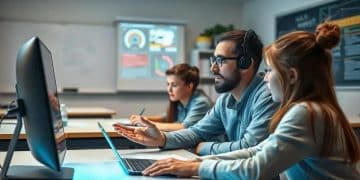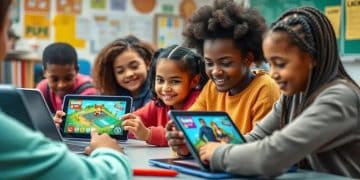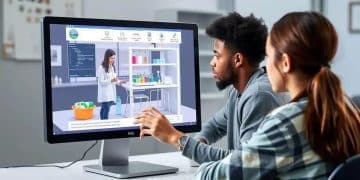Insights on remote learning platforms: what you need to know
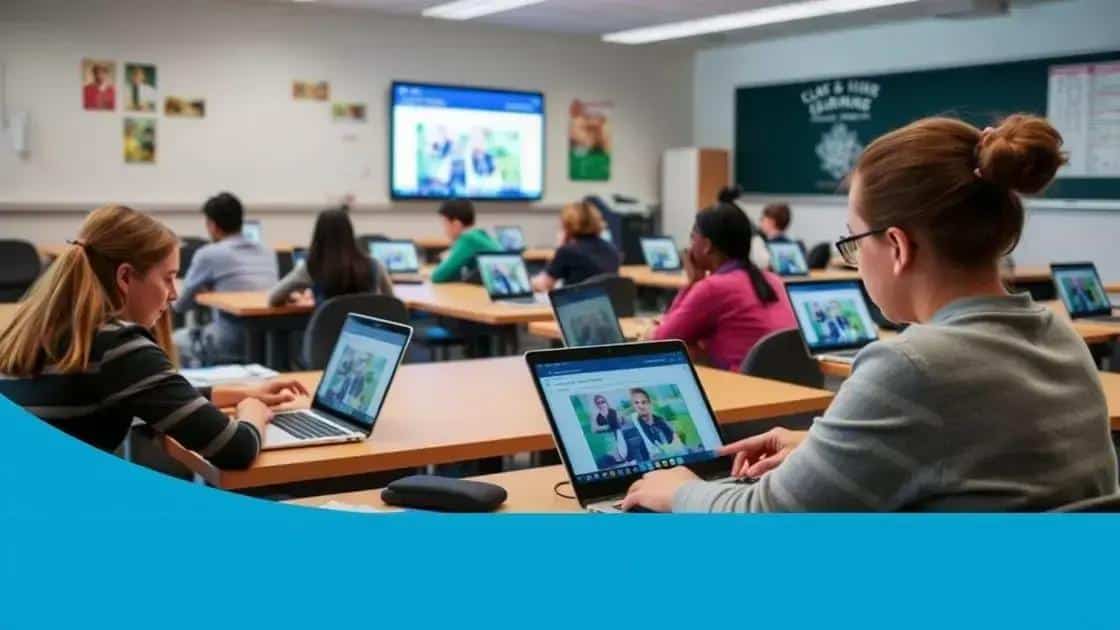
Insights on remote learning platforms highlight their benefits, challenges such as technical issues and engagement, and the importance of accessibility and effective assessment methods for enhancing the educational experience.
Insights on remote learning platforms are shaping how education is delivered today. As technology continues to evolve, these platforms offer unique opportunities to enhance learning experiences. But what really makes them effective? Let’s explore.
The evolution of remote learning platforms
The world of education has changed dramatically over the years. Remote learning platforms have played a key role in this transformation, enabling students and teachers to connect from anywhere. With advancements in technology, these platforms offer a variety of tools that enhance learning experiences.
Key Milestones in Remote Learning Evolution
In the early days, distance education relied heavily on mail and telephones. Now, online classes are accessible to anyone with an internet connection. This shift has made education more inclusive and widespread.
Features that Define Modern Platforms
Today’s remote learning platforms come equipped with features that improve user experience:
- Interactive tools: Features such as quizzes and polls keep students engaged.
- Video conferencing: Real-time interaction allows for a classroom-like experience.
- Resource sharing: Easy access to materials fosters collaboration and learning.
The incorporation of artificial intelligence further personalizes the learning journey, making education more adaptable to individual needs. By analyzing student data, platforms can tailor content to match different learning styles.
Furthermore, the flexibility these platforms offer is unmatched. Students can learn at their own pace and revisit lessons whenever necessary. This adaptability is crucial, although it requires self-discipline.
The Impact of COVID-19
The pandemic accelerated the adoption of remote learning. Schools had to quickly transition to online formats, revealing both strengths and weaknesses in existing platforms. This sudden shift pushed educators to innovate and adapt, improving tools and teaching methods across the board.
As a result, the focus on digital literacy increased, preparing students for a technology-driven future. The learning curve may be steep, but the rewards are significant.
Overall, the evolution of remote learning platforms signifies a positive change in education. With the right tools, students can thrive in any environment. The ongoing advancements promise even greater improvements in how education is delivered.
Key features of effective remote learning platforms
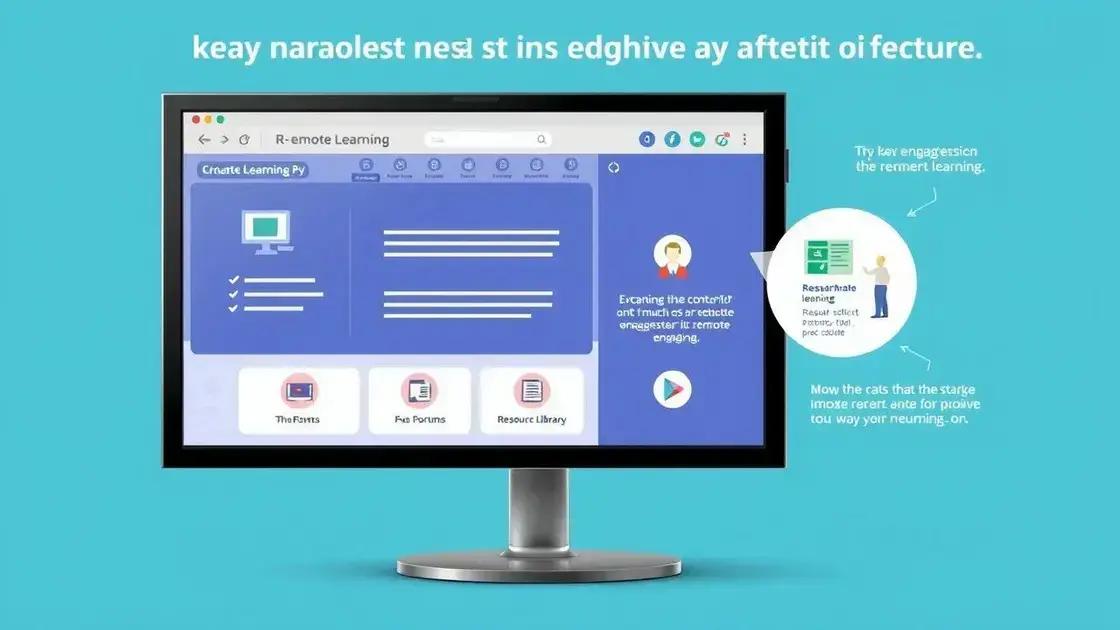
Effective remote learning platforms offer a variety of features that enhance the learning experience for both students and educators. Understanding these key features can help you make informed choices about which platform to use.
User-Friendly Interface
A simple and intuitive interface is crucial for both students and teachers. Users should be able to navigate the platform with ease, allowing them to focus on learning rather than troubleshooting. An organized layout keeps distractions to a minimum.
Engagement Tools
Engaging students is essential for remote learning success. Platforms should include:
- Interactive quizzes: These keep learning fun and help reinforce understanding.
- Discussion forums: Encouraging discussions among students enhances collaboration.
- Live polling: Real-time feedback helps teachers assess understanding immediately.
When students feel engaged, they are more likely to participate actively in their education.
Resource Accessibility
Easy access to learning materials is another important feature. Students should be able to view and download resources like videos and documents with minimal hassle. This feature supports different learning styles, allowing students to learn at their own pace.
Additionally, having a library of resources fosters a culture of independent learning. Students can explore topics that interest them beyond the standard curriculum.
Robust Support Systems
Lastly, effective remote learning platforms must provide strong technical support. Users should have access to resources like FAQs, live chat options, and tutorials. Quick and helpful responses to questions make the learning experience smoother and less frustrating.
Support systems play a vital role in helping students and teachers navigate challenges as they arise. This ensures a seamless learning journey.
How to choose the right remote learning platform
Choosing the right remote learning platform is essential for both students and educators. The correct platform can enhance the learning experience significantly, while the wrong choice can hinder progress.
Identify Your Needs
First, determine what features are most important for your learning or teaching style. Do you need video conferencing capabilities? Are interactive quizzes crucial? Understanding these requirements will help narrow down your options.
Evaluate Features
When reviewing platforms, consider these critical features:
- Accessibility: Ensure the platform is easy to use for everyone, including people with disabilities.
- Engagement tools: Look for platforms that offer quizzes, forums, and other interactive elements.
- Resource sharing: Check if the platform allows easy access to learning materials and collaboration tools.
These factors can greatly influence the effectiveness of the learning process.
Read Reviews and Feedback
Research is key in selecting the right platform. Read reviews from other educators and students. Look for testimonials that highlight strengths and weaknesses. This can provide valuable insights into what you can expect.
Investigating user experiences allows you to see how well a platform performs in real-life situations versus mere promises.
Consider Integration with Other Tools
Another important aspect is to check how well the platform integrates with other tools you may already be using. Compatibility with learning management systems or tools like Google Drive enhances the overall experience.
Seamless integration can save time and reduce confusion for both teachers and students. Make sure the platforms support any specialized tools vital to your curriculum.
Finally, always take advantage of free trials or demos. Exploring a platform firsthand can provide a clearer picture of its functionality and whether it suits your needs. Making an informed choice is crucial for effective remote learning.
Challenges faced by remote learning platforms

Despite their benefits, remote learning platforms face several challenges that can affect the educational experience. Understanding these challenges is important for educators and students alike.
Technical Issues
One major challenge is the prevalence of technical issues. Connectivity problems can disrupt learning, causing frustration for both students and teachers. Slow internet speeds or software glitches can lead to missed lessons and hinder engagement.
Lack of Engagement
Maintaining student engagement in a virtual environment is often difficult. Without face-to-face interaction, students may feel isolated or distracted. Educational platforms need to incorporate interactive tools that encourage participation, but many still struggle to achieve this.
Equity and Access
Another significant issue is equity and access to technology. Not all students have the same access to devices or reliable internet, creating disparities in learning opportunities. Schools must find ways to support those who are at a disadvantage, ensuring that every student has equal access to education.
Additionally, this lack of access can lead to increased dropout rates, which is a concern for educators striving to retain students.
Effective Assessments
Lastly, traditional assessment methods may not translate well to remote learning. In-person exams and assessments are challenging to replicate, leading educators to rethink evaluation strategies. Developing effective ways to assess student knowledge online can be complex but is vital for measuring progress.
Teachers and students must adapt to new forms of evaluation that accurately reflect learning outcomes.
FAQ – Common Questions about Remote Learning Platforms
What are remote learning platforms?
Remote learning platforms are online tools that facilitate educational experiences by enabling communication, resource sharing, and interactive learning among students and teachers.
What are the main challenges of using these platforms?
Some challenges include technical issues like connectivity problems, maintaining student engagement, ensuring equity in access to technology, and adapting assessment methods to an online format.
How can teachers enhance engagement on these platforms?
Teachers can enhance engagement by using interactive tools such as quizzes, discussion forums, and live polls, which encourage participation and collaboration.
Is access to technology a problem in remote learning?
Yes, access to technology is a significant concern as not all students have reliable internet or devices, which can create disparities in learning opportunities.



